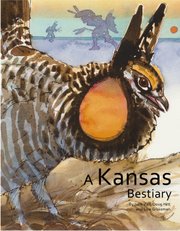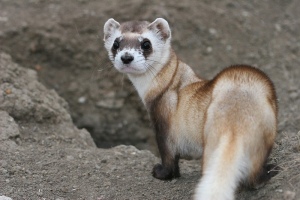As a part of our what’s so special about Kansas series, we reached out to the authors and artist of A Kansas Bestiary. Read our review of the book here and read on for their thoughts about what makes Kansas so special.
A bit about them from their website: Jake Vail lives in the Wakarusa watershed and works as a librarian in Lawrence, Kansas. Doug Hitt holds an M.A. in Earth Literacy and has studied with eco-philosopher Joanna Macy. Lisa Grossman is a painter and printmaker in Lawrence, Kansas, whose work focuses on the wide skies, prairies, and river valleys of Kansas.
Kansas Trail Guide: Our book with University Press of Kansas is all about trails in Kansas for hiking, biking, and horseback riding.
Many of the trails are in state and county parks. Do you have a favorite park or favorite trail in Kansas? If so, what is it that makes it special for you?
JV: I’d pick the long loop at Konza Prairie (my first exposure to the Flint Hills), and the Tallgrass Prairie National Preserve. Doug and I went for a two-day meander on the trails there during the writing of A Kansas Bestiary. From free-ranging bison to box turtles to scissor-tailed flycatchers and the great surprise of prairie chickens booming in the evening, it turned out to be a Kansas highpoint.
But remember that almost all of the state is private land. I’ve been fortunate to get to know some farmers and ranchers and see sides of Kansas that many people haven’t. We need more parks! (And “we” includes the critters.)
DH: My favorite trails are in the Tallgrass Prairie National Preserve near Strong City. The open vista of horizon and multi-hued flora, the breezy soundscape punctuated with insect hum and sparrow call unleash me from too-much-thought.
LG: By far, the trails I frequent most in all seasons for biking, hiking and foraging are the Kansas River Trails along the Kansas River in Lawrence. These start at the 8th St. boat ramp and wind eastward through the woods for a total of 13 miles (- I think) Experiencing them on an almost every-other-day basis allows me to feel the subtle and sometimes dramatic shifts in weather and season.
But for sheer inspiration and grandeur I’ll choose the main trail into the back country of the Tallgrass Prairie Preserve. It only takes about a mile of hiking to get yourself into the most vast, quiet expanse of prairie with very few obstructions on the horizon, which is so rare. You can really lose yourself there with a few miles of easy walking. Plus there are bison and it’s open 24 hrs.
Kansas Trail Guide: What inspired the writing of A Kansas Bestiary?
JV: Indirectly, moving to Kansas and then realizing so many people fail to appreciate it – here and elsewhere. More directly, Barry Lopez’s essays and Rebecca Solnit and Mona Caron’s A California Bestiary.
DH: The impetus for writing the Bestiary actually came from Rebecca Solnit and Mona Caron’s book, A California Bestiary; but, the actual inspiration–the driving force–came from the deep pleasure of encountering the creatures that we had chosen to honor.
LG: This is Jake and Doug’s to answer!
Kansas Trail Guide: What are some of the biggest Kansas misconceptions you think people have?
JV: That the opening scene of the Wizard of Oz portrays Kansas accurately.
DH: Foremost, the Great Plains are “plain.”
LG: That it’s big and empty.
Kansas Trail Guide: Out of staters often think of Kansas as “flyover country” – what would you say to change their minds?
JV: It wouldn’t change minds, but the history of Euramerican travel here is instructive. After Coronado and Zebulon Pike, eyes on a particular prize, both got lost, Kansas became “walk-over country,” to get most directly to the markets of Santa Fe, the green fields of Oregon, and the gold fields of California and Colorado. Now we drive the interstates (which started near Topeka, thanks to a Kansan) or move from big airport to big airport. Really, what isn’t flyover country?
DH: All ecoregions have their unique language. Some, the front range of Colorado for instance, shout grandeur. Others are quieter, more courteous, subtle. Attuning ourselves to the latter is a deep pleasure akin to reading haiku.
LG: Spend a few nights in the Flint Hills. That should do it.
Kansas Trail Guide: For someone who’s never been to Kansas, do you have any recommendations for where to go or what to see?
JV: If you’re interested in the bestiary, you’d be interested in the fairly new Flint Hills Discovery Center in Manhattan and the Wetlands Education Center at Cheyenne Bottoms. But mainly I’d recommend getting onto the back roads, and striking out on foot and taking time to explore.
DH: Tallgrass National Preserve, Cheyenne Bottoms, Quivira Refuge.
LG: I’d like to suggest different criteria for exploring Kansas. I’d ask you to seek out places rich in biodiversity, a natural silence, and the widest spans of unimpeded horizon you can find. If you find a place with all three it’s a treasure indeed.
Kansas Trail Guide: For someone who grew up in Kansas and feels like they’ve seen everything there, do you have any recommendations for where to go or what to see?
JV: Following Heraclitus, I believe you can’t step into the same Kansas twice. Visit a favorite place in all seasons, from different directions, in all kinds of weather, day and night, for a short time or a long time, and it will be different every time.
DH: I am one of these people! When I find local lodging in small towns like Council Grove, Herrington, Stafford and then spend several days attuning to the nearby wild areas, I experience unexpected adventure. The key word is “expectations.” How do these cause us to dismiss or minimize what is right before us? “Plain” is a state of mind.
LG: I’m from Pennsylvania and didn’t come to Kansas City until 1988, and I wondered where I could find the prairies. Local friends directed me to the Flint Hills and that changed everything for me. The open expanses and vast skies became my inspiration and vocation. Luckily, PrairyErth was published right after I got here so that deepened my understanding and appreciation for exploring the Flint Hills initially.
As I’ve lived here over 25 years now, I’ve come to appreciate the waterways, especially the Kansas River, where I’ve kayaked and encountered a whole new side of Kansas––170 miles of the Kansas Water Trail – all open to the public for recreation with boat ramps nearly every 10 miles. It’s fabulous.
Kansas Trail Guide: What makes Kansas special for you?
JV: It boils down to open skies and the frequent surprise.
DH: Expansive horizons, the subtle play of light on cloud and grass, the stormy intersection of high and low pressure zones.
LG: Especially as an artist, I can use the fact that Kansas is largely under-appreciated to challenge myself to convey the immense beauty I find here to those who don’t see it. Places like Santa Fe or Sedona are so obviously beautiful that there are 1000’s of artists there and I would find that a much more difficult situation!
The space itself is what I revel in here. My work invites folks to slow down and take the long way–to stop long enough to see which way the clouds are moving, how the light changes, to sharpen their awareness and senses to the place.


